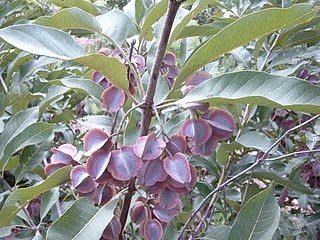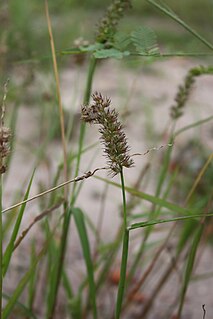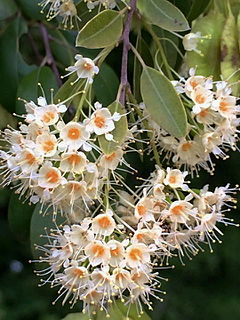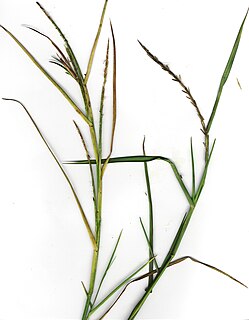
Combretum, the bushwillows or combretums, make up the type genus of the family Combretaceae. The genus comprises about 272 species of trees and shrubs, most of which are native to tropical and southern Africa, about 5 to Madagascar, but there are others that are native to tropical Asia, New Guinea and the Bismarck Archipelago, Australia, and tropical America. Though somewhat reminiscent of willows (Salix) in their habitus, they are not particularly close relatives of these.

Cocculus is a genus of 11 species of woody vines and shrubs, native to warm temperate to tropical regions of North America, Asia and Africa. The common name moonseed is also used for the closely related genus Menispermum. The related Indian berry is known as "Cocculus Indicus" in pharmacology.

Plant Resources of Tropical Africa, known by its acronym PROTA, is an international programme concerned with making scientific information about utility plants accessible in Africa, supporting their sustainable use to reduce poverty.
Acalypha bipartita is a species in the botanical family Euphorbiaceae. It occurs widely in Africa where it is eaten as a vegetable, or fed to animals. The leaves are considered nutritious, as they contain a high concentration of calcium. It is often found as undergrowth in the forest, on the edges of the forest, and in wooded grasslands, particularly in Sudan, Uganda, Kenya, eastern Zaire, Burundi, Rwanda, and Tanzania. The stems are often used in making baskets.

Acanthosicyos naudinianus, known as the Gemsbok cucumber, is a perennial African melon with edible fruits and seeds.

Cenchrus biflorus is a species of annual grass in the family Poaceae. Common names include Indian sandbur, Bhurat or Bhurut in India, Haskaneet in Sudan, Aneeti in the Arabic dialect of Mauritania, K 'arangiya in the Hausa language of Nigeria, and Ngibbi in the Kanuri language of Nigeria. In the francophone countries of the Sahel, it is usually referred to as "cram-cram".

Acalypha fruticosa is a species of flowering plant in the botanical family Euphorbiaceae. It occurs widely in East and southern Africa where it is eaten as a vegetable. It is also an important browse plant for sheep. In East Africa and southern Africa it is used as a medicinal plant. In northern Kenya arrow shafts and beehive lids are made from the stem. From the dried leaves a tea is made in Ethiopia.
Acalypha ornata is a species in the botanical family Euphorbiaceae. In Africa it is widely used as a medicinal plant. The stems are used as fibres for weaving baskets. The leaves are eaten as a vegetable; the plants are also fed to domestic animals. Acalypha ornata is sometimes planted as an ornamental plant.
Acalypha psilostachya is a species in the botanical family Euphorbiaceae. In East Africa it is used as a medicinal plant.

Combretum erythrophyllum, commonly known as the river bushwillow, is a medium to large-sized, spreading tree found in bush along river banks in southern Africa. It is planted as a shade and ornamental tree in South Africa and the United States, and is propagated by seed.

Combretum apiculatum is a species of tree in the family Combretaceae known by the common name red bushwillow. It is native to the mesic to semi-arid savanna regions of Africa, southwards of the equator.

Pteleopsis myrtifolia is one of some 10 African species in this genus in the family of Combretaceae. It is the only Pteleopsis species to occur in Southern Africa. Its flowers are strongly scented and perceived by humans to be either 'honey-like' or 'cloying' or even 'stinky'. The timber is red, hard and durable, and used for furniture and construction.

Indigofera hirsuta, the hairy indigo or rough hairy indigo, is a species of flowering plant in the family Fabaceae. It is native to nearly all the world's tropics; South America, Africa, Madagascar, the Indian Subcontinent, southern China, southeast Asia, Malesia, Papuasia and Australia, and has been introduced to the Caribbean, the southeast United States, Mexico and Central America. It is used as a green manure and, to a minor extent, for forage.

Grewia bicolor, called bastard brandy bush, false brandy bush, two-coloured grewia, white-leaved grewia, white-leaved raisin, white raisin and donkey berry, is a species of flowering plant in the family Malvaceae, native to Sub‑Saharan Africa, Yemen, Oman, and the Indian Subcontinent. In Africa Grewia bicolor is one of the most important forages during the dry season, when all herbivores, wild and domestic, find it palatable. It is particularly enjoyed by giant eland and domestic goats.

Indigofera spicata, the creeping indigo or trailing indigo, is a species of flowering plant in the family Fabaceae. It is native to Sub‑Saharan Africa, Madagascar, Mauritius, Réunion, and Yemen, and has been introduced to the southeastern United States, various Caribbean islands, Brazil and other locations in Latin America, various Pacific islands, and New South Wales and Queensland in Australia. It was considered to be a promising forage plant, and then shown to be toxic to nearly all livestock, but it is possible that the experiments were conducted on the similar Indigofera hendecaphylla, leading to some confusion.

Stylosanthes guianensis, the stylo, is a species of flowering plant in the family Fabaceae. It is native to the New World Tropics and Subtropics, and has been introduced to Puerto Rico, the Windward Islands, Trinidad and Tobago, most of Sub‑Saharan Africa, Madagascar, Mauritius, Réunion, Rodrigues, the Indian Subcontinent, Sri Lanka, Thailand, southeast China, Hainan, Taiwan, New Guinea, Queensland, New Caledonia, and the Cook Islands. An important forage and fodder species, its palatability to livestock increases as the plant matures, making it an unusual, and valuable, deferred feed. It has high genetic diversity between and among its named varieties.

Desmodium uncinatum, the silverleaf desmodium, is a species of flowering plant in the family Fabaceae, native to Latin America, and introduced as a fodder to various locales in Africa, India, New Guinea, Australia and Hawaii. Although chiefly a fodder, it can also be used for pasture, deferred feed, cut-and-carry, hay, ground cover, and mulch. It is considered invasive in Australia and Hawaii.

Stylosanthes humilis, the Townsville stylo, is a species of flowering plant in the family Fabaceae, native to the New World Tropics, and widely introduced as a forage to the tropics of Africa, India, Southeast Asia, Malesia, and Australia. A nutritionally valuable forage plant, it was nearly wiped out in Australia in the 1970s by an outbreak the fungus Colletotrichum gloeosporioides, which causes anthracnose disease.

Hemarthria altissima, variously called limpo grass, limpograss, halt grass, Batavian quick grass, swamp couch grass, red swamp grass and red vleigrass, is a species of flowering plant in the jointgrass genus Hemarthria, family Poaceae. It is native to the Old World Tropics and Subtropics; Africa, southern Europe, the Middle East, India, Southeast Asia, eastern China, and Borneo, and widely introduced as a forage in the New World, from Texas and Florida south to northern Argentina. In addition to being a valued forage for livestock, it makes a good, fragrant silage. A number of cultivars are commercially available.

Digitaria abyssinica, the East African couchgrass, is a species of flowering plant in the family Poaceae. It is native to Sub‑Saharan Africa, Madagascar, many of the Indian Ocean islands, the Arabian Peninsula, Sri Lanka, Peninsular Malaysia, Vietnam, New Guinea, and Queensland in Australia, and it has been introduced to scattered locations in Central America and northern South America, and to Saint Helena. Although it is a livestock forage, albeit a low‑quality one, it is generally considered a noxious weed.


















